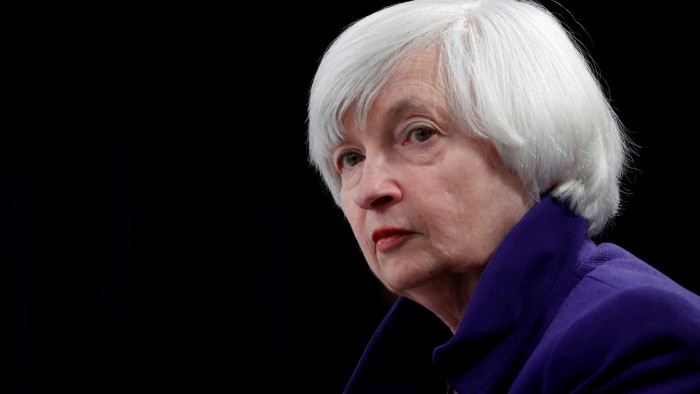The Fed’s quest for higher inflation looks doomed without Congress


Roula Khalaf, Editor of the FT, selects her favourite stories in this weekly newsletter.
In the week since the Federal Reserve announced that it would tolerate periods of higher inflation, top officials past and present at the US central bank have tried to fill in the sketch laid out by its chair, Jay Powell.
Vice-chair Richard Clarida affirmed that low unemployment alone will not spur increases in interest rates. Former chair Ben Bernanke likened the new strategy statement to a constitution that sets out broad principles, and said he expects the Fed to eventually roll out a more explicit form of guidance, tethering rate increases to certain economic metrics. And John Williams, the president of the New York branch, walked through why the new framework would enhance the Fed’s ability to boost prices and also the jobs market.
The Fed’s urgency to do more to aid the real economy is unsurprising, given that its policies have helped fuel one of the sharpest rebounds in the history of US markets. Meanwhile, so-called Main Street has languished, dogged by high unemployment and rising bankruptcies for small businesses. Narrowing Wall Street’s lead, then, has become more than simply a matter of financial stability. It is also about the Fed’s reputation.
For now, though, one thing has become clear: no one thinks the Fed can succeed without the aid of the government.
Messrs Clarida, Bernanke and Williams individually discussed this point in their public appearances this week, while Fed governor Lael Brainard added that “the magnitude and timing of further fiscal support is a key factor for the outlook”. Former chair Janet Yellen also chimed in, reiterating that monetary policy alone is insufficient given the scale of the downturn.
“There’s a little bit more the Fed can do — I would look at exploring the tool kit — but I think we also need fiscal policy in a situation like this,” she said.
Fixed income investors have also underscored the risk that Congress fails to do enough — not only in the near-term, with another relief package aimed at alleviating the economic damage from the coronavirus outbreak, but also over a longer horizon.
“The Fed going it alone without fiscal support likely leads to the frustratingly low levels of inflation that we’ve witnessed over the past decade,” said Dan Ivascyn, group chief investment officer at Pimco.
Market prices already reflect the doubts investors have about the Fed’s capacity to generate inflation, let alone an average level of 2 per cent over time as the new strategy stipulates. Longer-term Treasury yields initially rose sharply — reflecting falling prices — after Mr Powell’s announcement, suggesting concerns about inflation eroding the real value of the bonds’ fixed interest payments. But the sell-off has since lost momentum.
Meanwhile, a swap rate that measures expectations of the average level of inflation over five years, five years from now, hovers around 2 per cent. But the 10-year break-even rate — which serves as a proxy for investors’ inflation expectations over that longer period — has stalled below 1.8 per cent.
There are, of course, structural factors keeping downward pressure on prices. Investors point to the deflationary effects of an ageing population — a force that has been particularly strong in Japan. Technological advances have also played a part, as falling input costs have helped to keep a lid on prices.
Against this backdrop, the most recent tussle between congressional leaders over the pandemic response seems all the more worrying.
Prior to embarking on their summer recess, Democrats and Republicans failed to come to an agreement about another stimulus package, resulting in the lapsing of critical benefits for American households hardest hit by coronavirus-related lockdowns. Donald Trump stepped in to bridge the gap with four presidential orders, but economists argued the measures provided only limited relief and that the expiry of key benefits, such as $600-per-week in extra unemployment assistance, could hurt the nation’s recovery.
Congress is due to reconvene on September 8, and according to Greg Peters, a senior portfolio manager at PGIM Fixed Income, action is needed immediately to offset additional pain for consumers. Households had generally responded well to the giant spending packages passed by policymakers earlier this year.
“Time is slipping away here,” said Mr Peters. “Lay-offs are picking up and there is other meaningful scarring on the economy.”
Goldman Sachs reckons the next package is likely to be closer to $2tn, which is what Democrats are jockeying for, as opposed to the $1tn of relief backed by Republicans.
Diana Amoa, a fixed income portfolio manager at JPMorgan Asset Management, said policymakers also need to start thinking about more ambitious spending initiatives for the longer term, including those tied to infrastructure.
“If improvements in the real economy continue to lag badly, the Fed risks being blamed both for greater inequality and undue financial instability,” said Mohamed El-Erian, chief economic adviser for Allianz.
“The destiny of the Fed is in Congress’s hands.”
Comments